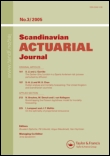
Scandinavian Actuarial Journal
Scope & Guideline
Advancing statistical excellence since 1918.
Introduction
Aims and Scopes
- Risk Modeling and Assessment:
The journal emphasizes the development and application of models for assessing various types of risks, including life, health, and financial risks. This includes advanced stochastic models, collective risk models, and methodologies for estimating ruin probabilities. - Investment Strategies and Financial Engineering:
Research on optimal investment strategies, especially in the context of pension funds and insurance products, is a core focus. This includes studies on asset-liability management and the interplay between insurance and investment. - Insurance Pricing and Valuation:
The journal covers methodologies for pricing insurance products, including variable annuities and reinsurance contracts. It explores innovative approaches to valuation that incorporate complex financial and risk factors. - Statistical and Computational Methods:
There is a strong emphasis on the use of statistical techniques, machine learning, and computational methods in actuarial science. This includes applications of Bayesian methods, copula models, and ensemble forecasting techniques. - Socioeconomic Impacts and Policy Design:
The journal also addresses the socioeconomic implications of actuarial practices, exploring topics such as demographic disparities in insurance pricing and the design of pension systems to enhance financial security.
Trending and Emerging
- Cyber Risk and Data Security:
Recent publications have increasingly focused on cyber risk modeling and the implications for insurance portfolios. This trend underscores the importance of addressing new risks associated with digital transformation and data breaches. - Advanced Machine Learning Techniques:
There is a significant uptick in the application of machine learning and artificial intelligence in actuarial science, particularly in pricing, forecasting, and risk assessment. This reflects a broader trend towards data-driven decision-making in the industry. - Intergenerational Risk Sharing and Pension Design:
Research on intergenerational risk sharing within pension systems has gained traction, indicating a growing interest in sustainable pension design that considers the long-term implications for multiple generations. - Complex Dependencies in Risk Models:
The journal is witnessing an increase in the exploration of complex dependencies among risks, particularly through the use of copula models and multivariate approaches, which enhance the understanding of joint risks in insurance. - Sustainability and Environmental Risks:
Emerging themes related to sustainability, including the assessment of environmental risks and their impact on insurance products, are becoming more prevalent, reflecting a shift towards incorporating social responsibility into actuarial practices.
Declining or Waning
- Traditional Risk Models:
There is a noticeable decline in the publication of papers focused solely on traditional risk models, such as basic actuarial models that do not incorporate advanced dependencies or modern statistical techniques. - General Mortality Forecasting:
While mortality forecasting remains a critical area, there is a shift away from simpler mortality models towards more complex, hybrid approaches. This indicates a waning interest in basic methodologies that do not integrate newer statistical advancements. - Static Insurance Pricing Models:
Static models for insurance pricing that do not consider dynamic factors or advanced data analytics are becoming less common. The focus is shifting towards more dynamic and adaptive models that incorporate real-time data and predictive analytics.
Similar Journals

Japanese Journal of Statistics and Data Science
Bridging Theory and Practice in Data ScienceJapanese Journal of Statistics and Data Science, published by SPRINGERNATURE, is a leading academic journal dedicated to the advancement of statistical methodologies and data science applications, with a focus on fostering innovative research and discourse within the field. Since its inception in 2018, the journal has sought to bridge theory and practice, embracing emerging trends and interdisciplinary approaches that contribute to the ever-evolving landscape of statistics, probability, and computational theory. Hailing from Germany, the journal holds an impressive Q3 ranking in both Computational Theory and Mathematics and Statistics and Probability, reflecting its commitment to high-quality, impactful research. With an accessible ISSN of 2520-8756 and E-ISSN 2520-8764, the journal invites a global audience of researchers, professionals, and students to explore its rich array of articles and findings, all aimed at furthering knowledge and application in the realm of data science.

International Review of Finance
Innovating discourse in the realm of finance research.International Review of Finance is a prestigious academic journal published by Wiley, located in the United Kingdom. With its ISSN 1369-412X and E-ISSN 1468-2443, this journal serves as an essential platform for researchers and practitioners in the fields of Economics and Finance. Ranked in the Q2 quartile for both Economics and Econometrics and Finance as of 2023, it showcases high-quality research that contributes significantly to theoretical and practical advancements. Reflecting its standing, the journal is positioned in the 61st percentile in Economics and Econometrics and the 60th percentile in Finance according to Scopus rankings. The scope of the journal includes a diverse range of topics, encouraging innovative discourse across various financial disciplines. Although it does not offer open access, the International Review of Finance continues to be an important resource for academics, professionals, and students seeking to deepen their understanding of evolving financial theories and practices.
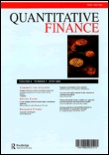
QUANTITATIVE FINANCE
Exploring innovative solutions in finance and econometrics.QUANTITATIVE FINANCE, published by Routledge Journals, Taylor & Francis Ltd, stands at the forefront of academic research in the dynamic fields of finance, economics, and econometrics. With a strong commitment to disseminating cutting-edge research, this esteemed journal, which has been published since 2001 and continues to thrive with an anticipated convergence until 2024, occupies a prestigious Q1 ranking in Economics, Econometrics, and Finance and a Q2 ranking in Finance as of 2023. It serves as an essential platform for interdisciplinary studies, aiming to bridge theoretical approaches and practical applications in quantitative methods. Researchers, professionals, and students are provided access to a wealth of high-quality articles that contribute to the ongoing discourse and advancements in these fields. As the journal continues to impact its community, QUANTITATIVE FINANCE remains an invaluable resource for those seeking to stay at the cutting edge of financial research and its applications globally.
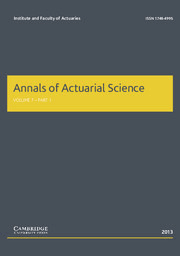
Annals of Actuarial Science
Exploring innovative insights in economics and statistics.Annals of Actuarial Science, published by Cambridge University Press, stands as a prominent academic journal in the fields of economics, statistics, and actuarial science. With an ISSN of 1748-4995, it features rigorous research aimed at advancing knowledge and practice in areas related to risk management, data analysis, and probability. The journal is recognized for its significant impact, holding a Q2 category ranking in both Economics and Econometrics and Statistics and Probability, along with notable positioning within Scopus rankings. Although it does not currently offer open access, its comprehensive selection of scholarly articles from 2010 to 2024 remains invaluable to researchers, professionals, and students alike, providing insights that drive the actuarial profession and enhance decision-making processes across various sectors. Positioned at the intersection of theoretical innovation and practical application, the Annals of Actuarial Science continues to shape the discourse and development of its disciplines.

FINANCE AND STOCHASTICS
Advancing the Frontiers of Financial MathematicsFinance and Stochastics is a leading academic journal published by Springer Heidelberg, focusing on the intricate interplay of finance, probability, and statistics. With an impressive impact factor and ranked within the Q1 category in both finance and statistics, it serves as an essential resource for researchers and professionals seeking to advance their understanding of stochastic modeling in financial contexts. The journal has maintained a strong reputation since its inception, with contributions from renowned scholars worldwide. The editorial team prioritizes high-quality research that addresses contemporary challenges in financial mathematics and extends the boundaries of statistical methods. Nestled in the heart of Germany, Finance and Stochastics embraces a broad scope, inviting submissions that explore innovative approaches to economic theory and quantitative methodologies. This combination of rigorous academic standards and commitment to impactful research makes the journal a pivotal avenue for disseminating knowledge and fostering collaboration in the finance and statistics communities.

Decisions in Economics and Finance
Fostering Excellence in Economic Decision-MakingDecisions in Economics and Finance, published by SPRINGER INT PUBL AG, is a leading journal in the fields of economics, econometrics, and finance, providing a critical platform for researchers, professionals, and students to disseminate their findings and insights. With an impressive impact factor positioned in the Q2 category for both Economics and Finance in 2023, this journal is recognized for its rigorous peer-reviewed process and impactful research contributions. The journal spans over areas of general economics and finance, emphasized by its Scopus rankings, which place it in the 68th and 50th percentiles respectively. Since its inception in 1997 and continuing through its conferred years, Decisions in Economics and Finance continues to foster innovative approaches to economic and financial decision-making while bridging theoretical and practical applications. While it currently does not offer Open Access options, its commitment to quality research and interdisciplinary collaboration makes it a vital resource for anyone engaged in these dynamic fields.

Journal of Computational Finance
Empowering decision-making with cutting-edge computational techniques.Journal of Computational Finance, published by INCISIVE MEDIA, stands at the forefront of interdisciplinary research, amalgamating the realms of finance, applied mathematics, and computer science. With its ISSN 1460-1559 and E-ISSN 1755-2850, this journal provides a vital platform for scholars and practitioners alike, aiming to advance methodologies and computational techniques that enhance financial decision-making processes. Although currently categorized in the Q3 quartile across various disciplines—including Applied Mathematics, Computer Science Applications, and Finance—its commitment to quality research is unwavering, as evidenced by its curated selection of innovative studies. The journal’s scope includes computational modeling, algorithmic trading, risk management, and quantitative finance solutions. Each volume seeks to not only foster academic discourse but also bridge theoretical findings with practical applications in the financial industry. Given its convergence from 2011 to 2024, the journal continues to evolve alongside the rapidly changing financial landscape, supporting researchers, students, and professionals in navigating the complexities of computational finance.
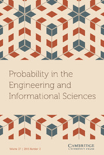
PROBABILITY IN THE ENGINEERING AND INFORMATIONAL SCIENCES
Transforming engineering challenges with cutting-edge probabilistic insights.PROBABILITY IN THE ENGINEERING AND INFORMATIONAL SCIENCES is a premier journal published by Cambridge University Press, dedicated to advancing the fields of statistics, probability, and their applications within engineering and informational sciences. With an ISSN of 0269-9648 and an E-ISSN of 1469-8951, this journal has established itself as a significant resource since its inception in 1987, continuing to publish impactful research through 2024. Ranking in the Q2 category for Industrial and Manufacturing Engineering and holding Q3 status in multiple relevant categories, it boasts a respectable impact in academia, reflected in its Scopus rankings across various disciplines. Although not an open-access journal, it remains essential for researchers interested in the integration of probabilistic methods in contemporary engineering challenges. By providing a platform for innovative studies and practical applications, PROBABILITY IN THE ENGINEERING AND INFORMATIONAL SCIENCES plays a crucial role in shaping future research and methodologies in these overlapping domains, fostering collaboration and knowledge exchange among researchers, professionals, and students alike.
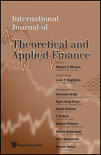
International Journal of Theoretical and Applied Finance
Unveiling the nuances of theoretical and applied finance.International Journal of Theoretical and Applied Finance is a distinguished publication in the field of finance, serving as a critical platform for the dissemination of innovative research and theoretical insights since its inception in 2003. Published by World Scientific Publishing Co Pte Ltd in Singapore, this journal boasts an impressive Q2 ranking in the realms of Economics, Econometrics, and Finance (miscellaneous) and a solid Q3 status in Finance for 2023. With a commitment to advancing knowledge in the complex world of theoretical frameworks and applied financial practices, it welcomes original research articles, comprehensive reviews, and case studies that explore varied facets of finance. Researchers, professionals, and students benefit from the journal's rigorous peer-review process and an ever-expanding repository of knowledge, making it an indispensable resource in the financial academic community. The journal does not currently offer open access, reflecting its selective approach to publishing high-quality content aimed at a specialized audience.
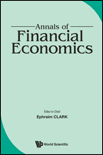
Annals of Financial Economics
Transforming Ideas into Insights in Finance and EconomicsAnnals of Financial Economics, published by World Scientific Publishing Co. Pte Ltd, is a premier scholarly journal catering to the fields of finance, economics, and international management. With an impressive impact factor and categorized in the Q2 quartile across multiple disciplines in the 2023 rankings, the journal holds a prominent position among its peers, evidenced by its ranking in the top 15% for Economics and Econometrics and Finance categories. The journal aims to foster high-quality, innovative research that addresses contemporary financial issues, making it a vital resource for researchers, professionals, and students alike. Although it does not operate under an open access model, it ensures that its contributions advance scientific discourse and provide valuable insights into financial theories, practices, and policies. With a historical publication span from 2005 to 2009 and again from 2011 to 2024, the Annals remains a critical platform for disseminating transformative ideas in financial economics, ensuring its relevance in a rapidly evolving scholarly landscape.